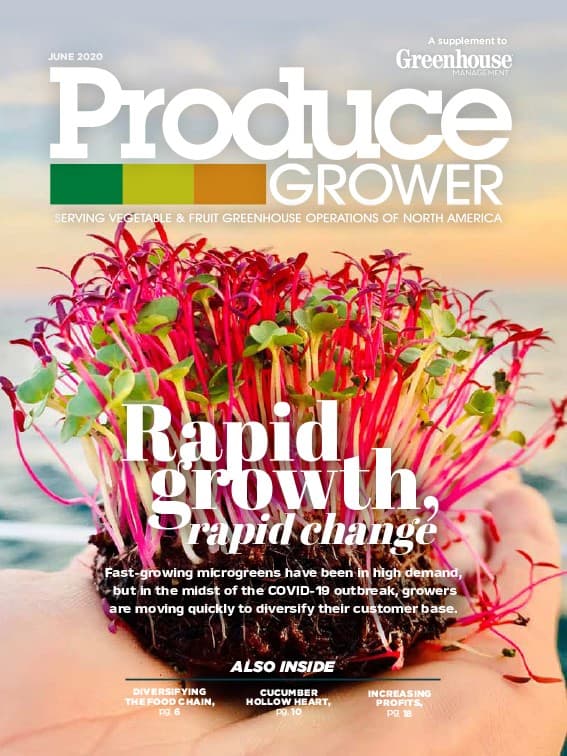

Seedless greenhouse cucumbers (Cucumis sativus) are a popular greenhouse crop due to their thin-skinned and seedless fruits, mild flavor and virtually ready-to-eat nature. However, have you ever cut open or bit into a cucumber to find it is not fully developed on the inside (Fig. 1)? This disorder is referred to as hollow heart. It is primarily associated with plants in the Cucurbitaceae, or “cucurbits”, which not only includes cucumbers, but melons and summer and fall squashes as well. This article will discuss the environmental factors and cultural practices needed to suppress the excessive growth rates of hollow heart development.
What causes hollow heart?
It is not uncommon to find fruits of other greenhouse and controlled environment crops — including tomatoes, peppers and strawberries — not fully developing. However, that is usually attributed to incomplete pollination or damage to flowers during pollination.
The cause of cucumber hollow heart is not related to pollination, especially since greenhouse cucumbers are parthenocarpic and set fruit without the need for flower pollination and ovule fertilization. Rather, cucumber hollow heart is caused by rapid growth rates.
Temperature
The rate of crop growth and development is strongly affected by the average daily temperature (ADT) and, therefore, reducing growing temperatures to slow down cucumber fruit growth can suppress hollow heart. Compared to other vine crops, cucumbers respond well to warm temperatures, with plants thriving day temperatures between 75° and 80° F. Reducing the day time air temperature to the mid- to lower-70s will reduce the ADT and slow down crop development. The ADT in a cucumber greenhouse can also be decreased by lowering the night temperature; however, be careful not to achieve a lower ADT by dropping the night temperature below 65° F since cucumber plants are sensitive to air temperatures cooler than this.

Nutrition
Mature cucumber crops can be fertilized with complete nutrient solutions with an electrical conductivity (EC) up to 3.0 mS/cm. However, healthy and productive cucumber plants can be grown with a lower EC, around 2.0 mS/cm. Reducing the EC and growing close to 2.0 mS/cm can reduce excessive growth rates. In addition to the total fertilizer provided to cucumbers (reflected in the EC), watch the amount of nitrogen being provided to cucumber. During the early growth stages of cucumber plant growth, higher proportions of nitrogen may be provided to plants to promote their vegetative growth to get plants sufficiently sized for transplanting, as well as established into systems after transplanting. However, once cucumbers enter their fruiting phase, less nitrogen should be provided relative to other nutrients. A good rule of thumb is to maintain a nitrogen-to-potassium ratio of 1:1.5; the elevated K is essential for the developing fruits. Lower nitrogen can lead to more manageable growth.
Irrigation
In addition to restricting fertilizers, reduce excessive irrigation to cucumber plants. If the substrate moisture is kept too high too consistently, excessive growth can occur. While drying down substrate is commonly done to steer vine crops from vegetative to generative (i.e. reproductive) growth, it can also be used in moderation to slow down growth. Monitoring substrate moisture, as well as leaching fractions, will help identify and manage excess irrigation and allow better wet-dry cycles to occur. However, be careful to not dry crops down to the point of imparting stress on plants so developing fruits are not aborted from excessive stress.
Light
Cucumbers are a high-light greenhouse crop, and their growth increases in response to increasing photosynthetic light. Due to their high light requirements, decreasing photosynthetic light can diminish fruit growth. However, although lowering the light intensity can suppress cucumber growth, this is not an advisable strategy to suppress the development of hollow heart in fruits, as reducing light will both reduce yield and post-harvest fruit quality from the reduced carbohydrate production. Focusing on environmental and cultural factors such as temperature, irrigation and nutrition to control cucumber growth and hollow heart is a better strategy.
Take-home
Do not let cucumber hollow heart leave you feeling empty on the inside! Moderating the rate at which cucumbers develop will help suppress hollow heart and help maintain fruit quality.
Keeping the average daily temperature in check and minimizing excessive nitrogen and substrate moisture can all contribute to produce fully filled and developed cucumbers and maintain your crop productivity and produce quality.

Explore the June 2020 Issue
Check out more from this issue and find your next story to read.
Latest from Produce Grower
- Chilli thrips (Scirtothrips dorsalis)
- GS1 US Celebrates 50-Year Barcode 'Scanniversary' and Heralds Next-Generation Barcode to Support Modern Commerce
- University of Florida offers Greenhouse Training Online program on irrigation water
- Flower trends in full bloom
- Nominate an outstanding leader
- New Florida Extension Agent Will Teach Stakeholders About Food Safety
- Paint it black
- Regular checkups





